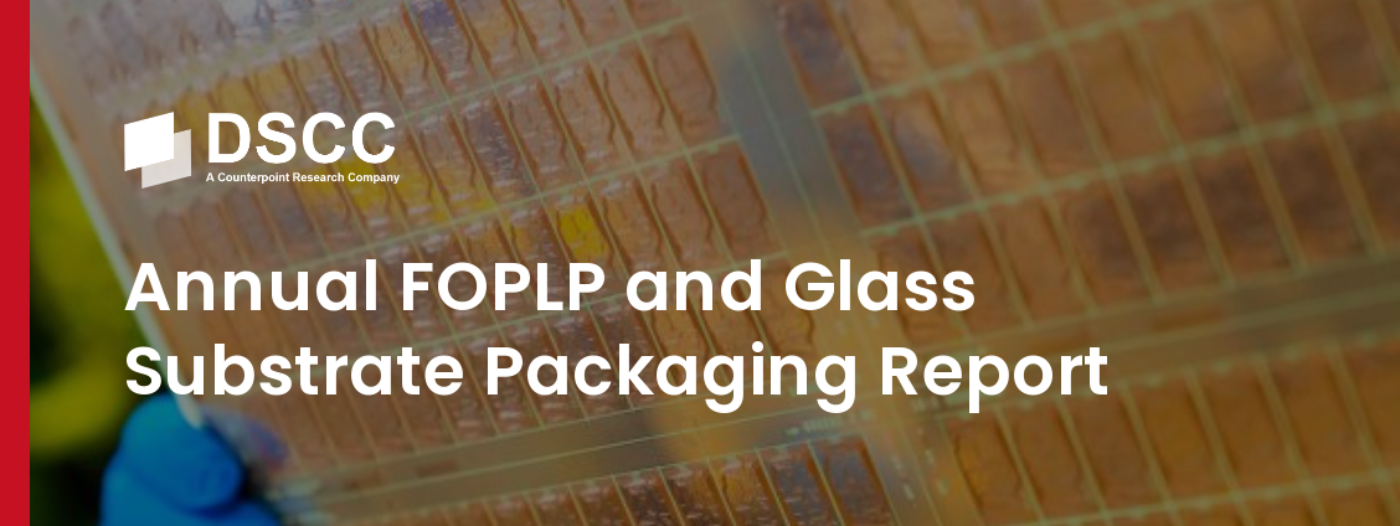ガラス基板パッケージング分野に見込まれる大きな成長機会~DSCCが新レポートを発刊
出典調査レポート Annual FOPLP and Glass Substrate Packaging Report の詳細仕様・販売価格・一部実データ付き商品サンプル・WEBご試読は こちらから お問い合わせください。
これらDSCC Japan発の分析記事をいち早く無料配信するメールマガジンにぜひご登録ください。ご登録者様ならではの優先特典もご用意しています。【簡単ご登録は こちらから 】
記事のポイント
- GSP (ガラス基板パッケージング) を含むFOPLP (ファン・アウト・パネル・レベル・パッケージング) 市場は年平均成長率29%で29億ドルへの成長が見込まれている。
- AI、HPC (高性能コンピューティング) 、通信、自動車、ディスプレイなど、数多くの用途でFOPLPの恩恵が期待される。2026年以降はAIとHPCがリードすると見られる。
- 半導体とディスプレイのサプライチェーン全体の企業がFOPLPとGSPへの移行によって利益を得ることになるだろう。
Counterpoint Research傘下のDSCCが2024年版 Annual FOPLP and Glass Substrate Packaging Report を発刊した。
200ページ超の本レポートは主要な先端半導体パッケージング手法を対象に2030年までの予測と分析を行っている。本レポートでは以下の詳細情報を提供している。
- 技術解説
- プロセスフロー
- 生産能力予測
- 需要予測
- 出荷数/出荷面積/出荷額予測 (用途別および技術別)
GSPを含むFOPLP市場は、2024年の約6億ドルから (※日本サイトで補足しました)、年平均成長率29%で2030年には約29億ドルに成長する見込みである。
FOPLPの急速な普及は、世界的な需要の高まりに後押しされている。
- AI (人工知能) および HPC (高性能コンピューティング) 市場では、高性能、拡張性、エネルギー効率を実現する先進パッケージングソリューションが求められる。FOPLPは、GPU/CPU/ASICにとってきわめて重要である、データ帯域幅と熱的性能の向上に貢献する。デバイスは非常に複雑かつ大型化しており、チップメーカーやパッケージングサプライヤーはガラス基板やFOPLPなどの新たなパッケージング手法に注目している。ガラス基板には優れた平坦性や優れた熱的・機械的安定性といった特長があり、こうした特長によって、AIを支えるチップパッケージの高密度化と高性能化が実現する。ガラス基板では、1つのパッケージに接続できるトランジスタ数が多く、より大きな構成のチップレットを組み立てることも可能である。
- 車載エレクトロニクス:PMIC (パワーマネジメントIC) やセンサー、ADASシステムに最適で、信頼性とコンパクト設計が実現する。
- ディスプレイ:GSP (S-PLP) は、MiniLED/MicroLEDディスプレイやAR/VR向けMicro OLED用途の重要な実現技術として浮上してきた。有機基板とは対照的に、GSP (S-PLP) は高い寸法安定性 (特にリフロー工程で) と低い反りを実現する。この2つの重要な特長により、トランスファーの歩留まりと信頼性の向上が可能になり、パッドピッチの微細化により、より小さなLEDを実装できるようになる。GSPはガラスベースのMicro OLEDにも利用可能だ。
ファウンドリやOSAT (半導体組立およびテスト受託) プロバイダ、FPDメーカー、PCBサプライヤーなど、半導体とディスプレイのサプライチェーン全体の企業が、FOPLPの商機を積極的に探っている。急速に進化するこの市場で競争力を維持するために、各企業は戦略と技術投資の足並みを揃えることの重要性を認識している。
おもな課題として、パネルサイズの標準化、反り制御、設備や装置の準備などが挙げられる。熱膨張性の低いガラスや先進接合技術など、材料におけるブレークスルーがFOPLPの拡張性を決定することになるだろう。
TSMC、Intel、Samsung、ASE、AUO、Innoluxなどの大手企業が、生産能力と用途の拡大に向けてFOPLPに多額の投資を行っている。新たな提携の動きやパイロット生産ラインなど、大規模採用の準備が整いつつある兆しも見られる。
経験豊かな台湾の先端半導体パッケージングのエキスパートが共同執筆者に名を連ねる本レポートは、「FOPLPは半導体業界の進化の最前線にあり、コスト効率に優れた高性能ソリューションをAIやHPCなどの用途に提供する。材料とプロセスの成熟にともない、FOPLPは数多くの産業でパッケージング技術に革命を起こすことが期待される。ガラス基板が使用されることから、ディスプレイサプライチェーンの企業はこの商機の獲得に有利なポジションにある」と述べている。
出典調査レポート Annual FOPLP and Glass Substrate Packaging Report の詳細仕様・販売価格・一部実データ付き商品サンプル・WEBご試読は こちらから お問い合わせください。
[原文] DSCC’s FOPLP and Glass Substrate Packaging Report Reveals Significant Growth Opportunities
- The Fan Out Panel Level Packaging (FOPLP) market, which includes glass substrate packaging (GSP), is expected to grow at a 29% CAGR to $2.9B.
- Numerous applications will benefit from FOPLP, including AI, HPCs, Communication, Automotive, Displays, etc. AI and HPCs are expected to lead from 2026.
- Companies throughout the semiconductor and display supply chains are poised to benefit from the shift to FOPLP and GSPs.
DSCC, a Counterpoint Research Company, has released its 2024 Annual FOPLP and Glass Substrate Packaging Report, highlighting significant advancements and growth trends in advanced packaging that will impact both the semiconductor and display supply chains.
The 200+ page report forecasts and analyzes all major advanced semiconductor packaging approaches out to 2030. The report provides detailed:
- Technology descriptions;
- Process flows;
- Capacity forecasts;
- Demand forecasts;
- Shipment forecasts in units, area, revenues by application and technology.
The Fan Out Panel Level Packaging (FOPLP) market, which includes glass substrate packaging (GSP), is expected to grow at a 29% CAGR to $2.9B.
The rapid adoption of FOPLP is fueled by rising demand in:
- Artificial Intelligence (AI) and High-Performance Computing (HPC) markets, which require advanced packaging solutions for higher performance, scalability and energy efficiency. FOPLP enhances data bandwidth and thermal performance, crucial for GPUs, CPUs and ASICs. Devices are becoming so complex and large that chipmakers and packaging suppliers are turning to new packaging approaches including glass substrates and FOPLP. Advantages of glass substrates include superior flatness and better thermal and mechanical stability which will allow for higher density and higher performance chip packages to support AI. Glass substrates enable more transistors to be connected in a single package and also enable the ability to assemble larger configurations of chiplets.
- Automotive Electronics: Ideal for PMICs, sensors and ADAS systems, enabling reliability and compact designs.
- Displays: GSP (S-PLP) has emerged as a key enabler for MiniLED/MicroLED displays and Micro OLEDs tailored for AR/VR) applications. A GSP (S-PLP) allows for higher dimensional stability (especially in the reflow process) and lower warpage as opposed to organic substrates. These two key advantages can improve transfer yield and reliability and can have finer pitch of pads to mount smaller LEDs. GSP can also be used for Micro OLEDs on glass.
Companies across the semiconductor and display supply chains, including foundries, outsourced semiconductor assembly and test (OSAT) providers, panel manufacturers and PCB suppliers, are actively exploring FOPLP opportunities. These players recognize the importance of aligning their strategies and technological investments to remain competitive in this rapidly evolving market.
Key challenges include standardization of panel sizes, warpage control and equipment readiness. Breakthroughs in materials, such as low-CTE glass and advanced bonding techniques, will determine FOPLP’s scalability.
Major players like TSMC, Intel, Samsung, ASE, AUO and Innolux are heavily investing in FOPLP to expand capacity and applications. Emerging partnerships and pilot production lines signal readiness for mass adoption.
According to the report co-authored by an advanced semiconductor packaging expert in Taiwan with many years of experience, “FOPLP is at the forefront of the semiconductor industry’s evolution, providing cost-effective, high-performance solutions for AI and HPC applications. As materials and processes mature, we expect FOPLP to revolutionize packaging technologies across numerous industries. Due to the use of glass substrates, companies in the display supply chain are well positioned to capture some of this opportunity.”

